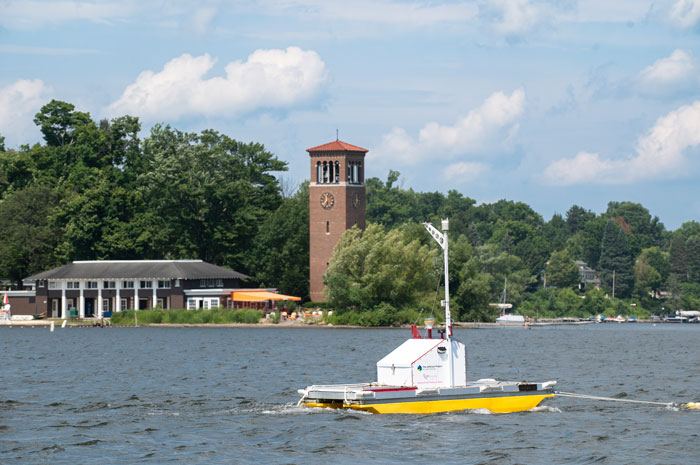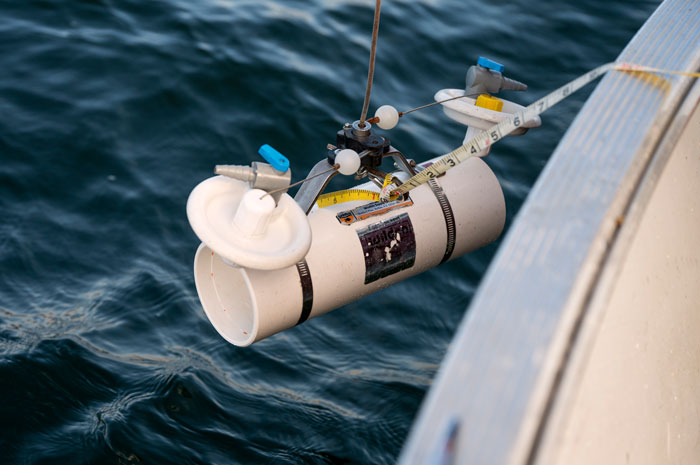The Problem
Now, decades of onshore development and resulting runoff have disrupted the ecology of the lake, encouraging growth of harmful algae blooms (HABs) and threatening the lake’s immediate and long-term health. The New York State Department of Environmental Conservation (DEC) has labeled Chautauqua Lake as “impaired,” under requirements of the U.S. Clean Water Act. Eutrophication — meaning excessive nutrients — is the primary cause of impairment. Ecological challenges such as eutrophication and climate change could reduce residents and visitors’ ability to enjoy the lake and negatively impact native flora and fauna. Left unchecked, these challenges could ultimately lead to a reduction of tourism in the area, shaking the region’s economy and devaluing the property around the lake, an existential threat to the county, the region and the Institution.
The Goal
Chautauqua Institution will work with Chautauqua County and other key stakeholders to contribute to research, mitigation and preservation efforts on Chautauqua Lake. The impact of this conservation effort will be felt throughout the entire community, personally and economically. Ultimately, this collaborative effort will decrease HABs and promote healthy vegetation and lake ecology.
The Plan
As one of many organizations around Chautauqua Lake, the Institution seeks to work together with the county and municipalities that surround the lake, as well as other nonprofit groups working hard to improve the lake’s water quality. This collaborative approach is important, as it gives the community the best chance to take positive action on addressing the lake’s ecological challenges.
What is the Institution best positioned to contribute to this combined effort? We see three categories of effort: Research, Collaboration, and Education
- Research: attracting more research to better understand the stressors on the lake
- Collaboration: with local and regional lake organizations to share learnings and work toward effective solutions
- Education: educational efforts to inform the public on the state of the lake and how it affects them
Research
Building on the research from the past two summers, Chautauqua Institution will continue to work with The Jefferson Project. This summer, research will begin on the mechanics of nutrient pollution in the lake. Utilizing boat-based sampling, sensors and computer modelling, the project will collect data on how factors like weather and water currents affect HAB growth, where nutrients are entering the lake, and how the north and south basins of the lake interact with and affect each other. There will also be targeted sampling of tributaries and areas around the lake, using advanced technologies and computer modeling to form a more accurate picture of how the lake ecosystem works.
In future years, the project will adopt a multidisciplinary approach to evaluate the data and confirm findings. As the Jefferson Project shares the results of their research, we will work with the greater community to apply their research to lake management solutions.
Collaboration
Chautauqua Institution recognizes that we are one part of a team of municipalities, organizations and dedicated citizens who are deeply committed to improving the health of Chautauqua Lake. It is critical that the work that we do complements or contributes to the work of other entities around the lake, so that we can all find and implement effective remediation to the ecological challenges of the lake.
Outreach
Public engagement and education on Chautauqua Lake’s water-quality challenges is also important. Chautauqua Institution hosted the 2022 Chautauqua Lake Water Quality conference as an opportunity for the public to hear about the research happening on the lake directly from scientists who are involved. The Institution will continue to facilitate similar gatherings in the future. Additionally, we are expanding our lake education to youth and family programs on the Chautauqua grounds during the summer, including water-quality sampling classes. The Institution also hosts local schools on the grounds in the spring, and water-quality awareness programs are offered during these field trips. We will continue to look for ways to engage the public on the state of the lake.
Stormwater Management
Chautauqua Institution has implemented the first steps of a comprehensive Drainage Management Plan that addresses stormwater flow throughout the grounds. This is the first comprehensive action taken by a lakeside community on Chautauqua Lake.
The plan is also supported by two grants awarded by New York state totaling $696,000.
In November 2010, Institution staff was presented with the report conducted by Foit-Albert Associates, an architecture and engineering firm based in Buffalo, N.Y., with a history of designing environmentally proactive stormwater management systems on the grounds. The firm reviewed the existing storm sewer system at Chautauqua and used topographical data and actual rainfall data to calculate and map the flow of stormwater and performance of storm sewers.
Foit-Albert reviewed state and federal environmental policies as well as local priorities. Specifically, the NYS Draft Chautauqua Lake TMDL (Total Maximum Daily Load) document that will affect storm water discharge nutrient management requirements and the recently prepared Chautauqua County Chautauqua Lake Management Plan were considered.
The Drainage Management Plan divides Institution property into 13 separate and distinct drainage areas, what are called “mini watersheds.” Improvements for each area were identified and prioritized. The plan calls for significant action:
- Reduce nutrient input to the lake
- Retain water where it falls
- Eliminate or decrease runoff discharge into Chautauqua Lake
- Remove nutrients from water running into lake
- Employ best management practices
- Serve as a demonstration community
The Institution was awarded two grants totaling $696,000 from Environmental Protection Agency and Clean Water Act funds distributed through the New York State Green Innovation Grant Program for the construction of an environmentally proactive surface and sub-grade stormwater management system. The Institution is required to provide a 10-percent matching investment.
Efforts already taken under the Stormwater Management Plan have proven effective, including a wetlands area near South Gate and rain gardens at Fletcher Hall, Peck Ave. and South Lake, and in University Park; and buffer gardens at the Glidden shoreline.
Rain Gardens
Chautauqua Institution completed a Sustainable Shoreline Action Plan in 2013, calling for several improvements, including the installation of rain gardens. There are a total of 33 rain gardens on the Institution’s grounds, with 21 of them having been added since 2015.
Once nutrient-rich water gets into Lake Chautauqua it is almost impossible to filter the nutrients back out. So the concept behind rain gardens and no-mow zones is to preemptively and naturally filter the water of its nutrients before it reaches the lake.
Water flow-rate slows at it enters the garden, allowing for larger particles and sediment to settle out, and for other suspended solids to be filtered out as the water is absorbed into the soil.
Excess nutrients dissolved in runoff water are taken up and stored by the plants, which prevents them from contaminating the lake.
Rain Garden Fun Fact:
Despite what their name might imply, rain gardens are actually dry most of the time (except after rainfall events, when they absorb water). They look just like normal gardens!
Native plants that tolerate a range of wet and dry conditions are used in these gardens since they are at times flooded with water and at other times experience dry conditions.



